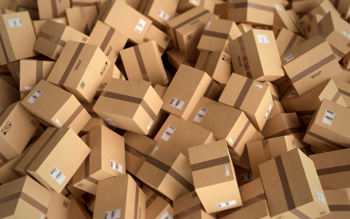
Indirect and Direct carbon emission contributions
When we think about carbon emission contributions, we must consider our impact both directly and indirectly. As a consumer I may chose to reduce my direct impact by buying goods online rather than driving to the shops. However, my indirect impact could be higher if the goods have not been sourced in a sustainable way. For example, I may be sent the goods directly from overseas rather than from a local manufacturer.
From a fulfilment perspective, it’s true that direct carbon emission contributions are relatively low and have significantly decreased compared to other industries. Office of National Statistics industry data shows that in 2020, the UK Transport and Storage industry emissions contribution was 11.3% of the total and has dropped by 44.7% since 2005; however indirectly when considering offshore manufacturing, international and local shipping those emissions contributions quickly ramp up.
All that considered, there are several ways you can consider reducing your carbon footprint both directly and indirectly. Let’s look at some of these and the relative impact each will make.
Warehouse Power
The warehouse is the heart of any fulfilment business, it holds all your revenue generating assets and is where is where all the action happens (sorry, finance). It, therefore, makes sense to start here with where you can look to reduce your carbon footprint.
Renewal Energy Sources
It will be no surprise that warehouses have large roofs. Those roofs are doing not a lot other than collecting rainwater and dirt, I guess also keeping people and stock dry too. Those large, flat roofs are also the ideal for solar panels to generate electricity.
LED Lighting
Most of us have switched old filament bulbs with LED’s in our houses; why not continue the trend into your warehouse. Yes, they cost a bit more to buy but they last a lot longer so will save you in the long run, and use a fraction of the power compared to fluorescent alternatives. Win-win.
Walls and doors
Warehouses are notoriously difficult to maintain the optimum temperature. Particularly if you store goods that need to be a kept within a specific temperature window. Partitioning your warehouse into smaller spaces, and insulating walls and doors can be great ways to improve temperature control; whilst reducing energy usage.
Electric Forklifts
Keeping with the theme of electricity; replacing those combustion powered forklifts with electric powered units can reduce the carbon footprint by a large amount. Not only that they also require less maintenance which can provide some operational cost savings.
Shipping efficiency
Probably one of the biggest areas to reduce emissions is in shipping. The type of packaging used and distance goods need to travel will have a huge impact on your direct and indirect emissions.
Warehouse location
Limiting the total distance goods must travel is a great way of minimising carbon emissions. We’ve seen increases in those opening warehouses in new geographies, both internationally and within UK. Whereas for others operating as a 4PL or partnering with Amazon through their Fulfilled By Amazon service is more appealing.
Packaging
In recent years there have been several initiatives to raise awareness and utilisation of more sustainable packaging options. Those have well documented benefits, but in addition to this being savvy with how you package multi-product orders can have a big positive impact too. Being able to calculate the minimum volume of packaging can be a great way to save cost as well as carbon footprint.
Logistics planning
Whether you run your own fleet of vehicles or use 3rd party courier services; you can be emission sensitive. Optimising the routes your drivers take, or choosing logistic partners who are more environmentally conscious, are both great ways to be more sustainable.
Supplier Choice
Following on nicely from being conscious of the partners you choose for logistics; the same approach applies to those of you that source your goods from suppliers rather than manufacture you own. Thinking carefully about your suppliers approach to product sustainability, the volume you can purchase at once, and the location of their manufacturing facilities can all have an impact.
Business Operations
Finally, looking at your businesses general operational practices is another great way to be more environmentally conscious.
Can you go fully paperless? Not only will this reduce your carbon footprint but will also save you a tonne of money in printer ink and paper.
Are there ways you could reduce the volume of client returns? Consumers often intentionally order more products when returns are free. Free returns is a good selling point, but charging for returns could reduce the unnecessary wastage. To offset any impact in reduction of sales, you could look to optimise your listings further, with more detailed descriptions, high quality images/videos, and/or size guides.
Regular analysis of highest emission area’s not only increases your own awareness but can also be a great marketing tool. Being able to show consumers and partners how you are monitoring and optimising your carbon emissions, could be an important factor in their decision-making process.* **
** https://hbr.org/2019/06/research-actually-consumers-do-buy-sustainable-products?ref=blog.smile.io
How can Warehouse Management Software Mintsoft help you to reduce emissions?
Although we’re not looking to enter the solar panel installation business, or sell you electric forklifts, there are many ways in which a Warehouse Management Software (WMS) System such as Mintsoft can support you in reducing your carbon footprint. These include:
- Going paperless by accessing all your information digitally, including mobile picklists.
- Enabling remote working through utilising our cloud-based software.
- Easily monitoring your inventory levels and therefore preventing you from losing stock and overordering which could end up going to waste.
- Organising location of stock to optimism your warehouse space; so you don’t need to move to larger premises as soon. Plus optimising the layout has other advantages such as minimising the distance forklifts need to travel.
If you’d like to further explore the benefits of implementing a WMS, you can read our full breakdown of the advantages and disadvantages of a warehouse management system.
We’d be happy to show you more about our WMS system, if you’d like to see the system in action, please book a demo with one of our product experts.

